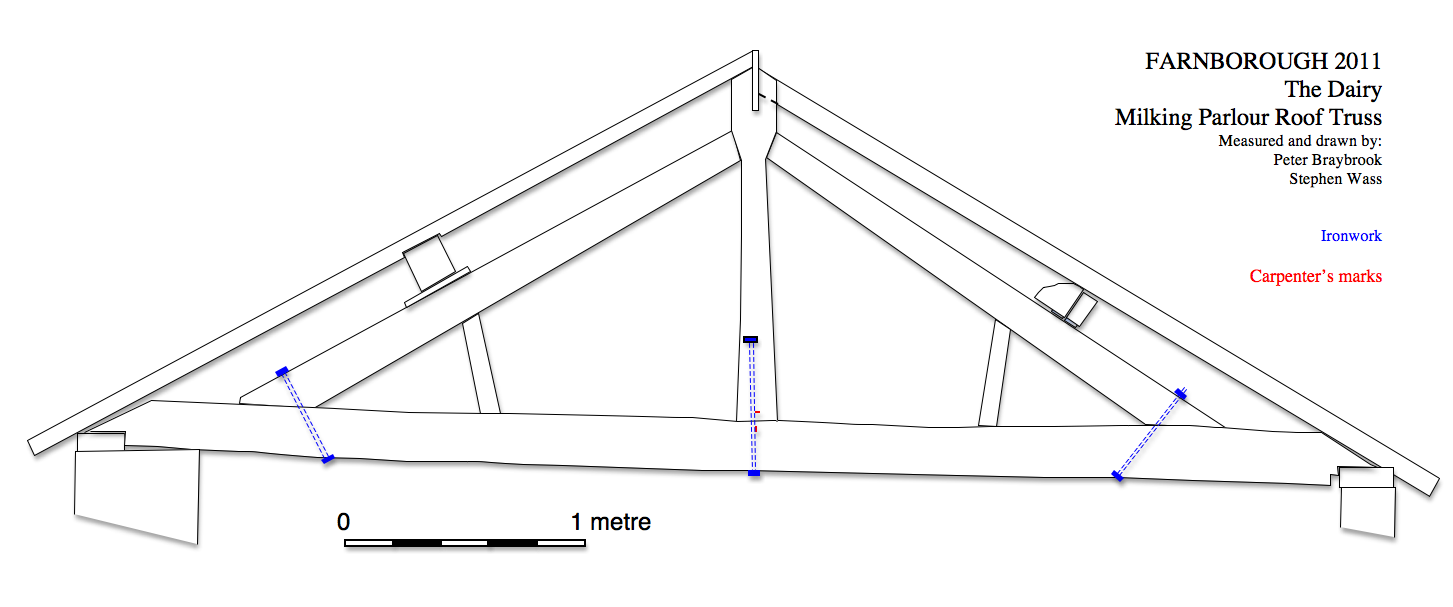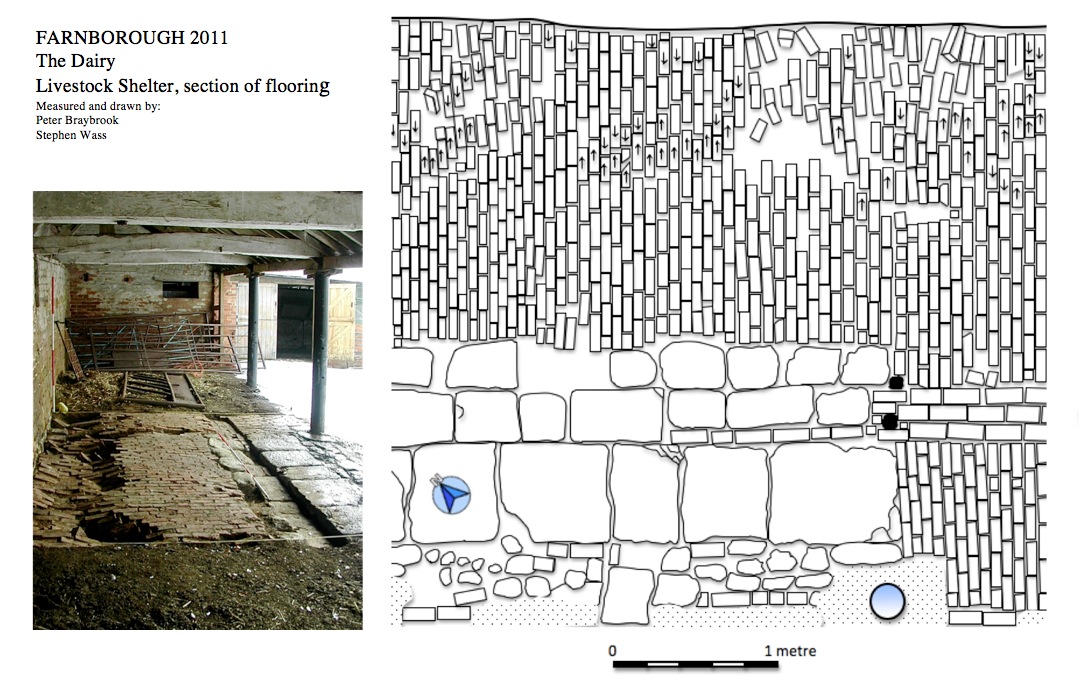January/February 2012
Back to Project Contents and Introduction
There
was not a huge amount of out and abouting in December, nor for that
matter in early January as, apart from Christmas, I was occupied with a
couple of heavy duty assignments for Leicester. One of these was the
'level three' report on the Dairy. This was sent off half way through
January yet within a couple of weeks I was thinking I really opught to
rewrite bits of it following further discoveries!
Firstly Peter was kind eough to wield a pencil while I clambered up and down the ladder to produce a measured drawing of a representative roof truss from the other part of the Dairy - the bit we called the milking parlour. What became evident was that its similarities to the roof structure above the livestock shelter were more assumed than actual. It is fairly clear that new common rafters were put on to the roof on the yard side located differently on the ridge board and possibly inserted when the brick walling was put in.

The other fascinating feature which emerged later in January was the complexity of the flooring in the livestock shelter. We had been aware that there was a combination of brick, stone and concrete under the trodden deposits of dried manure but it wasn't until I brushed and scraped some of it away along a metre wide strip that I realised there was much more going on here. We eventually clerared an area 4m by 4m and very interesting it was too. The western portion consisted of fairly irregular brick paving laid as headers but this was backed by a well made stone drain running down the length of the shelter. However, there was a distinct break with the eastern portion where the entire surface was laid in brick including the drain. In addition there was evidence of a series of timber post settings which must have supported a partition. Most curious of all was the fact that a section of the floor lining up adjacent to the north wall had collapsed into a linear feature of some kind. The tumbled nature of the bricks and the depth to which they had sunk, up to 0.3 metres suggested an almost catastrophic collapse presumably as the result of something like the roof of a timber lined culvert rotting and subsiding into the void below. What the function of another drain in such a location may be remains unclear.The western portion consisted of fairly irregular brick paving laid as headers but this was backed by a well made stone drain running down the length of the shelter. However, there was a distinct break with the eastern portion where the entire surface was laid in brick including the drain. In addition there was evidence of a series of timber post settings which must have supported a partition. Most curious of all was the fact that a section of the floor lining up adjacent to the north wall had collapsed into a linear feature of some kind. The tumbled nature of the bricks and the depth to which they had sunk, up to 0.3 metres suggested an almost catastrophic collapse presumably as the result of something like the roof of a timber lined culvert rotting and subsiding into the void below. What the function of another drain in such a location may be remains unclear.

Farnborough, The Dairy - livestock shelter. flooring looking north-east and plan.
Firstly Peter was kind eough to wield a pencil while I clambered up and down the ladder to produce a measured drawing of a representative roof truss from the other part of the Dairy - the bit we called the milking parlour. What became evident was that its similarities to the roof structure above the livestock shelter were more assumed than actual. It is fairly clear that new common rafters were put on to the roof on the yard side located differently on the ridge board and possibly inserted when the brick walling was put in.

The other fascinating feature which emerged later in January was the complexity of the flooring in the livestock shelter. We had been aware that there was a combination of brick, stone and concrete under the trodden deposits of dried manure but it wasn't until I brushed and scraped some of it away along a metre wide strip that I realised there was much more going on here. We eventually clerared an area 4m by 4m and very interesting it was too. The western portion consisted of fairly irregular brick paving laid as headers but this was backed by a well made stone drain running down the length of the shelter. However, there was a distinct break with the eastern portion where the entire surface was laid in brick including the drain. In addition there was evidence of a series of timber post settings which must have supported a partition. Most curious of all was the fact that a section of the floor lining up adjacent to the north wall had collapsed into a linear feature of some kind. The tumbled nature of the bricks and the depth to which they had sunk, up to 0.3 metres suggested an almost catastrophic collapse presumably as the result of something like the roof of a timber lined culvert rotting and subsiding into the void below. What the function of another drain in such a location may be remains unclear.The western portion consisted of fairly irregular brick paving laid as headers but this was backed by a well made stone drain running down the length of the shelter. However, there was a distinct break with the eastern portion where the entire surface was laid in brick including the drain. In addition there was evidence of a series of timber post settings which must have supported a partition. Most curious of all was the fact that a section of the floor lining up adjacent to the north wall had collapsed into a linear feature of some kind. The tumbled nature of the bricks and the depth to which they had sunk, up to 0.3 metres suggested an almost catastrophic collapse presumably as the result of something like the roof of a timber lined culvert rotting and subsiding into the void below. What the function of another drain in such a location may be remains unclear.

Farnborough, The Dairy - livestock shelter. flooring looking north-east and plan.